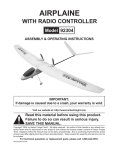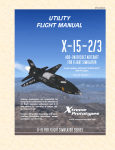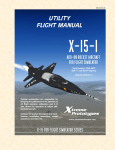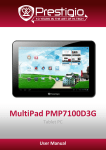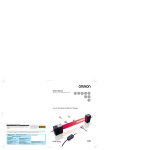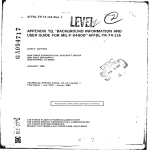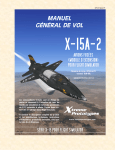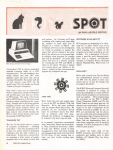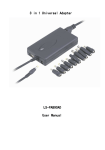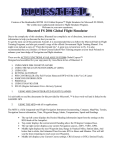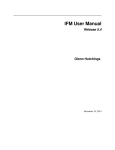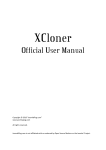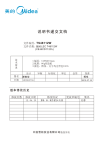Download UTILITY FLIGHT MANUAL X-15A-2
Transcript
XP-X15A2-1E
UTILITY
FLIGHT MANUAL
X-15A-2
ADD-ON ROCKET AIRCRAFT
FOR FLIGHT SIMULATOR
Serial number: AF56-6671
(XLR-99 engine)
ENGLISH VERSION 1.0
Desktop commanders are responsible for
bringing this publication to the attention of
all flight simulator enthusiasts and X-15
fans cleared for operation of subject addon rocket aircraft.
Contains full product description and specifications, installation instructions, normal
procedures and check list.
Xtreme
Prototypes
www.xtremeprototypes.com
X-15 FOR FLIGHT SIMULATOR SERIES
TABLE OF CONTENTS
FOREWORD
Section
Section
Section
Section
Section
Section
I
II
III
IV
V
VI
4
INTRODUCTION AND PRODUCT DESCRIPTION
1-1
SOFTWARE INSTALLATION
2-1
AIRCRAFT DESCRIPTION AND SPECIFICATIONS
3-1
INSTRUMENT PANELS
4-1
NORMAL PROCEDURES AND CHECK LIST
5-1
CONDENSED PROCEDURES AND CHECK LIST
6-1
APPENDICES
Appendix 1:
QUICK-START PROCEDURES
A-1
Appendix 2:
INSTRUMENT READINGS
A-2
Appendix 3:
FS AIRCRAFT REFERENCE INFORMATION
A-3
Appendix 4: PRODUCT SPECIFICATIONS
A-4
Appendix 5: SELECTED INTERNET LINKS
A-5
Appendix 6: SELECTED BIBLIOGRAPHY
A-6
Appendix 7: OTHER X-15 FOR FLIGHT SIMULATOR PRODUCTS by Xtreme Prototypes
A-7
Xtreme Prototypes X-15A-2 for Flight Simulator, Version 1.0 – Utility Flight Manual
3
GENERAL ARRANGEMENT
X-15A-2 (FULL WHITE
ABLATIVE COATING VERSION)
1
34
33
2
32
3
4
31
30
29
5
6
28
27
7
8
26
9
10
24
25
11 12 13 14
22
23
15
21
16
17
20
18
19
Figure 3-2
1. MOVABLE HORIZONTAL STABILIZER
2. WING (2, LEFT AND RIGHT)
3. UPPER SPEED BRAKE
4. MOVABLE UPPER VERTICAL STABILIZER
5. 29-INCH FUSELAGE EXTENSION
6. LIQUID OXYGEN TANK (FROST)
7. APU EXHAUST (2, LEFT AND RIGHT)
8. EQUIPMENT COMPARTMENT
9. CANOPY
10. COCKPIT CAMERA
11. ELLIPTICAL WINDOW (2)
12. PILOT (FULL PRESSURE SUIT)
13. EYELID (OUTSIDE OF LEFT WINDOW)
14. COCKPIT LIGHT (2)
15. ENGINE TIMER (STOPWATCH)
16. PITOT HEAD
42
41
43
40
3
39
4
38
31. REAR LANDING GEAR SKID (2, ON BOTH
SIDES)
32. LOWER SPEED BRAKE
33. IMPACT RAKES
34. DUMMY RAMJET (EXPERIMENTAL)
35. INSTRUMENT PANEL
36. FLAP (2, LEFT AND RIGHT)
37. MODIFIED LOWER FIXED VERTICAL STABILIZER (RAM JET ENGINE REMOVED)
38. HYDROGEN PEROXIDE JETTISON PORT
39. AMMONIA JETTISON PORT
40. XLR-99 ROCKET ENGINE
41. LIQUID OXYGEN JETTISON PORT
42. ENGINE TURBOPUMP EXHAUST
43. SPHERICAL HELIUM TANK
17. RETRACTABLE PITOT HEAD
18. NACA/NORTRONICS BALL NOSE
19. EXTERNAL CANOPY EMERGENCY JETTISON
HANDLE ACCESS DOOR
20. NOSE LANDING GEAR
21. NOSE LANDING GEAR DOOR
22. RADAR ANTENNA
23. UHF ANTENNAS
24. EJECTION SEAT
25. LEFT EXTERNAL PROPELLANT TANK (LOX)
26. SIDE FAIRING (2, LEFT AND RIGHT)
27. TANK EJECTOR (2, FORWARD & AFT, ON
EACH TANK)
28. TANK ROCKET THRUSTERS (ON EACH TANK)
29. RIGHT EXTERNAL PROPELLANT TANK (NH3)
30. TANK PYLON (ON EACH TANK)
1
32
37
6
5
31
33
26
25
36
2
7
30
8
9
29
11
27
35
21
Xtreme Prototypes X-15A-2 for Flight Simulator Version 1.0 – Utility Flight Manual
3-5
20
18
17
13
WITH INERTIAL ALL-ATTITUDE FLIGHT DATA SYSTEM,
XLR-99 ENGINE AND EXTERNAL DROP TANKS (X-15A-2)
MAIN PANEL
* Gauges in gray do not perform any specific simulator function.
23 24
25 26 27 28 29 30 31 32 33 34 35 36 37 38 39 40 41 42 43
44 45 46 47 48 49
50
22
21
20
19
51
52
18
17
16
53
54
55
56
57
58
15
14
13
12
11
10
9
8
7
6
5
4
59
3 2 1
87 86 85 84 83 82 81 80 79 78 77 76 75
74
73 72 71 70 69 68 67 66 65 64 63
62
61 60
Figure 4-1
1.
2.
3.
4.
5.
6.
7.
8.
9.
10.
11.
12.
13.
14.
15.
16.
17.
18.
19.
20.
21.
22.
23.
24.
25.
26.
27.
28.
AMMONIA JETTISON STOP SWITCH
H2O2 JETTISON STOP SWITCH
LIQUID OXYGEN JETTISON STOP SWITCH
H2O2 SOURCE PRESSURE GAUGE (INT./EXT.)
AUXILIARY LAUNCH SWITCH*
ENGINE MASTER SWITCH
DISPLAY/HIDE LEFT SIDE PANEL ICON
ENGINE RESET BUTTON
LANDING GEAR HANDLE
AMMONIA TANK PRESSURE-LOW CAUTION
LIGHT
VENTRAL (OR RAMJET) JETTISON BUTTON
PROPELLANT EMERGENCY PRESS SWITCH
PROPELLANT SOURCE PRESSURE GAUGE
(INT./EXT.)
LIQUID OXYGEN PRESSURE-LOW CAUTION
LIGHT
ENGINE VIB MALFUNCTION CAUTION LIGHT
TURBOPUMP OVERSPEED CAUTION LIGHT
HELIUM RELEASE SELECTOR SWITCH
STAGE 2 IGNITION MALFUNCTION CAUTION
LIGHT
VALVE MALFUNCTION CAUTION LIGHT
IDLE-END CAUTION LIGHT
NO-DROP OR 23-SECOND CAUTION LIGHT
IGNITION-READY LIGHT
DISPLAY/HIDE LEFT WHITE CONSOLE ICON
DISPLAY/HIDE THROTTLE AND SPEED BRAKE
PANEL ICON
ALTIMETER
AIRSPEED/MACH INDICATOR
PILOT’S OXYGEN-LOW CAUTION LIGHT
LEFT (LIQUID OXYGEN) EXTERNAL TANK
JETTISON-READY INDICATOR LIGHT
29.
30.
31.
32.
33.
34.
35.
36.
37.
38.
39.
40.
41.
42.
43.
44.
45.
46.
47.
48.
49.
50.
51.
52.
53.
54.
55.
56.
57.
58.
ANGLE-OF-ATTACK INDICATOR
ACCELEROMETER
EXTERNAL TANKS FUEL FLOW INDICATOR
RIGHT (AMMONIA) EXTERNAL TANK JETTISON-READY INDICATOR LIGHT
DISPLAY/HIDE EXTERNAL DROP TANKS CONTROL PANEL ICON
ATTITUDE INDICATOR
DYNAMIC PRESSURE INDICATOR
ENGINE TIMER (STOPWATCH)
FIRE-WARNING LIGHT
SIDESLIP SELECTOR SWITCH
HYDRAULIC PRESSURE GAUGE
INERTIAL SPEED (VELOCITY) INDICATOR
INERTIAL HEIGH (ALTIMETER) INDICATOR
PITCH ANGLE SET CONTROL
NO. 1 BALLISTIC CONTROL SWITCH
NO.1 GENERATOR-OUT LIGHT
VERTICAL VELOCITY INDICATOR
NO.1 GENERATOR SWITCH
GENERATOR AC VOLTMETER
EMERGENCY BATTERY SWITCH
NO. 2 GENERATOR-OUT LIGHT
HYDROGEN PEROXIDE TRANSFER SWITCH
NO. 2 GENERATOR SWITCH
NO. 2 BALLISTIC CONTROL SWITCH
NO.1 APU H2O2 COMPARTMENT OVERHEAT
WARNING LIGHT
NO. 2 APU H2O2 COMPARTMENT OVERHEAT
WARNING LIGHT
NO. 2 APU COMPARTMENT CAUTION LIGHT
DISPLAY/HIDE SERVICE PANEL ICON
NO.2 APU SWITCH
NO. 2 APU H2O2-LOW CAUTION LIGHT
59.
60.
61.
62.
63.
64.
65.
66.
67.
68.
69.
70.
71.
72.
73.
74.
75.
76.
77.
78.
79.
80.
81.
82.
83.
84.
85.
86.
87.
CANOPY INT. EMERGENCY JETTISON HANDLE
DISPLAY/HIDE RIGHT PANEL ICON
STABLE PLATFORM SWITCH
CABIN HELIUM SOURCE PRESSURE GAUGE
CABIN PRESSURE ALTIMETER
MIXING CHAMBER TEMPERATURE GAUGE
APU BEARING TEMPERATURE GAUGE
NO.1 APU H2O2-LOW CAUTION LIGHT
NO. 1 APU COMPARTMENT OVERHEAT CAUTION LIGHT
APU SOURCE PRESSURE GAUGE
APU H2O2 TANK PRESSURE GAUGE
NO. 1 APU SWITCH
CLOCK
DISPLAY/HIDE ICONS: RADIO PANEL, ATC
WINDOW, GPS, COMPASS, MAP, KNEEBOARD
RATE-OF-ROLL INDICATOR
SAS/RAS PANEL (SEE FIGURE 4-10)
DISPLAY/HIDE CENTRAL PEDESTAL ICON
PROPELLANT MANIFOLD PRESSURE GAUGE
CHAMBER AND STAGE 2 IGNITER PRESSURE
GAUGE
PROPELLANT PUMP INLET PRESSURE GAUGE
IGNITER IDLE SWITCH
READY-TO-LAUNCH SWITCH
FUEL LINE-LOW CAUTION LIGHT
TURBOPUMP IDLE BUTTON
H2O2 TANK AND ENGINE CONTROL LINE
PRESSURE GAUGE
ENGINE PRIME SWITCH
PROPELLANT TANK PRESSURE GAUGE
ENGINE PRECOOL SWITCH
H2O2 COMPARTMENT-HOT CAUTION LIGHT
Xtreme Prototypes X-15A-2 for Flight Simulator, Version 1.0 – Utility Flight Manual
4-2
3.
Data switch [18, fig.
4-8] – ON.
4.
Calibrate instrumentation button [2,
fig. 4-8] – Push
once (button green
light should come ON for 3 seconds, then OFF, indicating instrumentation calibration).
5.
Ready-to-Launch switch [80, fig. 4-1] – Test ON.
Ready-to-Launch (green) indicator light on service
panel [10, fig. 4-2] should come ON. Turn OFF
Ready-to-Launch switch. Ready-to-Launch (green)
indicator light on service panel should come OFF.
6.
Indicator, caution and warning lights – Check.
Place the indicator, caution, and warning light test
switch [7, fig. 4-4] at TEST (up position). All indicator, caution, and warning lights (except the fire
warning light) will come ON. This is only a test of
the bulbs. Return the switch to NORMAL (down
position).
this switch to OFF (in the left position) turns off the aircraft’s avionics and the GPS (see page 5-23).
TAXI (CARRIER AIRPLANE)
In the real world: The following procedures were done
during taxi and before takeoff of the carrier airplane.
Make sure the canopy is closed at this time.
1.
SAS function switches and (amber) lights [74, fig. 41; 1-4, 5-6, 15-16, fig. 4-10] – Check. Move SAS
function switches to LO GAIN and check lights
(should come OFF). Return function switches to
STD BY after each function trips.
2.
Radar beacon switch [13, fig. 4-8] – ON.
X-15A-2 for Flight Simulator after servicing.
BEFORE TAKEOFF (CARRIER AIRPLAINE)
CAPTIVE TAXI AND FLIGHT
In the real world: The following procedures were done
before takeoff of the carrier airplane.
1.
1.
Ram-air lever [15, fig. 4-8] – CLOSED.
2.
Helium release switch [17, fig. 4-1] – AUTO.
3.
Jettison stop switches [1-3, fig. 4-1] – STOP.
Radio function selector switch [3, fig. 4-5] – Turn
right to MIDDLE position (Main, T/R; Aux.,
ADF).
NOTE: The radio function selector switch [3, fig. 4-5]
must stay in this (middle) position or be turned further
right for the simulator’s GPS to be turned on. Turning
In the real world: The X-15 pilot would check and report
Xtreme Prototypes X-15A-2 for Flight Simulator, Version 1.0 – Utility Flight Manual
5-13
In the real world: During the cruise-climb to launch altitude, the pilot of the NB-52 carrier would start the timeto-go sequence and confirm with the launch operator that
the liquid oxygen top-off is satisfactory. The following
procedures would be performed at an altitude of between
35,000 to 45,000 feet.
1.
3.
No. 1 generator out (amber) light [44, fig. 4-1] –
Check OFF.
4.
APU switch No. 2 [57, fig. 4-1] – ON. As APU No. 2
comes up to speed, hydraulic pressure will increase
and then stabilize at 3000 to 3500 psi.
5.
No. 2 generator switch [51, fig. 4-1] – Move No. 2
generator switch momentarily to RESET, then to
ON.
6.
No. 2 generator out (amber) light [49, fig. 4-1] –
Check OFF.
7.
Stable platform power switch
[61, fig. 4-1; 9, fig. 4-4] – INT
(up position).
8.
Service panel external power
switch [25, fig. 4-2] – OFF.
9.
Service panel external power
(yellow) light [26, fig. 4-2] –
Check OFF.
Ram-air lever [15, fig. 4-8] – CLOSED.
PRELAUNCH
BEFORE COUNTDOWN
Before countdown, complete final cockpit check as follows:
1.
Ram-air lever [15, fig. 4-8] – Check CLOSED.
2.
Ventral arming switch [3, fig. 4-4] – Check ARM.
APUs:
When the APUs are operating, steam should be observed
coming out of the APU exhaust pipes.
1.
APU switch No. 1 [70, fig. 4-1] – ON. As APU No. 1
comes up to speed, hydraulic pressure will increase
and then stabilize at 3000 to 3500 psi.
2.
No. 1 generator switch [46, fig. 4-1] – Move No. 1
generator switch momentarily to RESET, then to
ON.
10. Generator (AC) voltmeter [47, fig. 4-1] – Check
(both pointers, 200 volts, internal).
11. Hydraulic pressure gauge [39, fig 4-1] – Check
(both pointers, 3000 to 3500 psi).
12. DC voltmeter selector switch [12, fig. 4-8] – Check
BUS.
13. DC voltmeter [11, fig. 4-8] – Check (28 volts).
Xtreme Prototypes X-15A-2 for Flight Simulator, Version 1.0 – Utility Flight Manual
5-15
2.
Vent, pressurize, and jettison control lever [5, fig. 47] – JETTISON.
3.
Jettison stop switches [46, fig. 4-3] – JETT for
about 3 seconds then
STOP. In the spot plane
exterior view, check for
vapor emitting from the
jettison ports, at the back
of the X-15 aircraft.
4.
External tanks fuel flow indicator [31, fig. 4-1] –
Check (both pointers, about 80% during jettison test).
NOTE: The liquid oxygen and ammonia jettison ports are
the long tubes protruding at the back of the airplane’s
side fairings (each side of the engine compartment). The
hydrogen peroxide jettison port is located inside the lower
speed brake compartment (right side). Because of some
limitations of the FS2004 platform, there is no special
effect associated with the APU H2O2 jettison.
plied to the engine turbopump. The hydrogen
peroxide tank is also
pressurized and H2O2
will be supplied to the
turbopump
cut-off
valve.
In the real world: The
X-15 pilot would check
and report the following instruments. If instruments are not within limits, the
pilot would check with ground control for an alternate
mission.
1.
Propellant tank pressure gauge [85, fig. 4-1] –
Check ("L" pointer, 45 to 65 psi; "A" pointer, 45
to 65 psi).
2.
External tanks
fuel flow indicator
[31, fig. 4-1] –
Check (both
pointers, about
50% after initial
pressurization).
Fuel flow will
gradually increase to about 80% during the jettison check
and up to 100% during engine operation.
3.
H2O2 tank and engine control line pressure gauge
[83, fig. 4-1] – Check (“C” pointer, 575 to 615 psi;
“T” pointer, 425 to 475 psi).
4.
DC voltmeter selector switch [12, fig. 4-8] –
STRAIN GAGE.
5.
Check strain
gauge (battery)
power supply (24
volts) on DC
voltmeter [11,
fig. 4-8].
6.
DC voltmeter selector switch [12, fig. 4-8] – BUS.
7.
SAS function switches [6, 15-16, fig. 4-10] – LO
GAIN. Check that the pitch, roll, and yaw caution
(amber) lights are OUT.
8.
Flight controls – Check.
The three propellants (liquid oxygen, ammonia and hydrogen peroxide) are being dumped overboard through the
jettison ports at the back of the X-15A-2.
Propellant tank pressurization:
1.
Vent, pressurize, and jettison control lever [5, fig. 47] – PRESSURIZE.
When the vent, pressurize, and jettison control lever is
moved to PRESSURIZE, ammonia and liquid oxygen
tanks are pressurized and the propellants will be sup-
In the real world: The X-15 pilot would move all flight
Xtreme Prototypes X-15A-2 for Flight Simulator, Version 1.0 – Utility Flight Manual
5-17
(forward) position. Then pull the throttle back to
its minimum position.
20. Telemeter and radar switches [16, 13, fig. 4-8] –
Recheck.
21. Telemeter commutator motor switch [17, fig. 4-8] –
Check ON.
22. Communications – Check.
In the real world: Check communication with ground
station, carrier pilot, and chase pilots.
23. Ready-to-Launch switch [80,
fig. 4-1] – ON.
In the real world: Verbally check
with carrier pilot and launch operator that the Ready-to-Launch
light is on.
while the engine is purged with helium and the igniter
spark plugs are energized. When this phase is completed,
the ignition-ready light comes on again.
26. Chamber and stage 2 igniter pressure gauge [77, fig.
4-1] – Check (small pointer, 150 psi in about 5
seconds,
when
stage 2 is ignited).
Flames
should be observed
inside the rocket
engine bell (nozzle)
as stage 1 and
stage 2 are ignited.
The main chamber and
stage 2 igniter pressure
will increase during engine operation and will vary according to the movement of the throttle.
Ready to launch! In the real world: Countdown by carrier pilot.
24. Ready-to-Launch (green) light on Service Panel [10,
fig. 4-2] – Check ON.
Operation of igniter idle is limited to 30 seconds. When 7
seconds remain of the normal igniter idle phase, the nodrop or 23-second (amber)
caution light [21, fig. 4-1] will
come ON. With the no-drop
or 23-second (amber) caution
light on, the pilot must terminate the igniter idle phase –
by moving the engine prime
switch to STOP PRIME – or
continue on to the launch
phase.
In the real world: The igniter
idle phase must be terminated
immediately if the idle-end
(amber) caution light [20, fig. 4-1] comes on, as damage to
the engine chamber will occur because of insufficient cooling.
25. Igniter idle switch [79, fig. 4-1] – IGNITER.
When the igniter idle switch is placed to IGNITER, the
ignition-ready light [22, fig. 4-1] goes out for 2 seconds
Igniter idle phase.
BALLISTIC CONTROL AND REACTION AUGMENTATION SYSTEM OPERATION
Since some missions will involve flight at altitudes where
control surfaces are ineffective and where ballistic control system operation will be required to maintain airplane attitude, the ballistic control system should be
Xtreme Prototypes X-15A-2 for Flight Simulator, Version 1.0 – Utility Flight Manual
5-19
When the fuel selector switch [7, fig. 4-9] on the external
tanks control panel [fig. 4-9] is set to EXTERNAL
(propellant system pressurized), a transfer system is activated and the propellant is transferred from the external
Placing the switch to MANUAL activates the manual
mode of the external tank release system. To release the
tanks, the pilot must press the external tanks jettison
empty button [3, fig. 4-9]. If the tanks are full, the pilot
must actuate the external tanks jettison full switch [4,
fig. 4-9]. Either full or empty jettison switches will release the tanks if the system is armed.
IMPORTANT NOTE: Use the external tanks jettison
full switch to release full tanks for successful tank separation. Do not use the external tanks jettison empty
button to release a full tank, as serious damage to
the tanks and airplane will result.
To arm the external tank release system and select the
manual mode, proceed as follows:
tanks to the internal tanks. At the end of a preset time
period, an intervalometer times out, deactivating the
transfer system, and the two external tanks jettisonready indicator lights in the cockpit [28, 32, fig. 4-1] come
ON, indicating that the tanks are ready to be released.
The propellant feed system automatically shifts to the
internal tank feed.
1.
Make sure the external tanks option switch on the
service panel [12, fig. 4-2] is set to INSTALLED.
2.
Fuel selector switch [7, fig. 4-9] – EXTERNAL.
3.
External tanks jettison safe-arm switch [6, fig. 4-9]
– ARM.
4.
External tanks jettison auto-manual switch [5, fig.
4-9] – MANUAL.
IMPORTANT NOTE: The maximum Mach number to be
reached by the X-15A-2 aircraft with the external tanks
attached is 2.6. The tanks must be released before
reaching that speed (see appendix 3).
When the fuel selector switch [7, fig. 4-9] on the external
tanks control panel [Fig. 4-9] is set to INTERNAL
(propellant system pressurized), the transfer system is
deactivated and propellant feed is from internal tanks
only, regardless of propellant remaining in the external
tanks.
The external tanks jettison safe-arm switch [6, fig. 4-9]
controls arming of the external tank release circuit.
When the external tanks jettison auto-manual switch [5,
fig. 4-9] is set to AUTO (fuel selector switch at EXTERNAL and external tanks jettison safe-arm switch to
ARM), the automatic mode of external tank release system is activated. When the intervalometer (see above)
times out, the external tanks are automatically released.
X-15A-2 quickly accelerating to high Mach numbers after
her external propellant tanks have been released.
Once the external tanks are released, the X-15A-2 will
quickly accelerate to higher Mach numbers until the pilot
Xtreme Prototypes X-15A-2 for Flight Simulator, Version 1.0 – Utility Flight Manual
5-22
ENGINE START
to 65 psi).
After release from the “carrier airplane” or when ready to
take off from the runway, proceed as follows:
7.
H2O2 tank and engine control line pressure gauge
[83, fig. 4-1] – Check (both pointers, 575 to 615
psi).
8.
External tanks fuel flow indicator on the main instrument panel [31, fig. 4-1] – 50% to 100%.
On the throttle and speed brake panel:
1.
Throttle [1, fig. 4-6] – START
(click and then move inboard
to 50%). Throttle must be moved
to 50% by the time the idle-end
(amber) caution light [20, fig. 4-1]
comes on.
Note that combustion in the main
thrust chamber of the XLR-99 engine
on the X-15 for Flight Simulator will
occur almost instantaneously when the throttle lever is
moved from OFF to START 50%.
XLR-99 engine start on the X-15A-2 for Flight Simulator.
The XLR-99 engine produced nearly 60,000 pounds of
thrust at high altitude.
NORMAL INDICATIONS DURING START
When the thrust chamber or chambers are fired, the following indications will be evident:
2.
Chamber and stage 2 igniter pressure gauge [77, fig.
4-1] – Check (large pointer, 335 to 600 psi
within 2 seconds, depending on throttle position; small pointer 350 to 630 psi, depending
on throttle position).
3.
Propellant manifold pressure gauge [76, fig. 4-1] –
Check ("L" pointer, 455 to 980 psi; "A" pointer,
510 to 1155 psi).
4.
Propellant (helium) source pressure gauge [13, fig.
4-1] – Check (both internal and external tanks,
3300 to 3900 psi).
5.
H2O2 source (helium) pressure gauge [4, fig. 4-1] –
Check (both internal and external tanks, 3300
to 3900 psi).
6.
Propellant tank pressure gauge [85, fig. 4-1] –
Check ("L" pointer, 45 to 65 psi; "A" pointer, 45
Turbine whine;
Turbine exhaust steam will be seen at the back of
the aircraft;
Liquid oxygen and ammonia will automatically stop
bleeding overboard (as observed during prime);
Liquid oxygen and ammonia manifold pressure will
rise to rated values;
Igniters will be operating;
Chamber pressure will rise to a point where the
igniters cease firing and chamber pressure will be
shown on the indicator gauge;
Airplane propellants will be consumed at a very
high rate, as can be observed on the volume gauges
[1-3, fig. 4-2] on the X-15A-2 for Flight Simulator
service panel;
Chamber pressure will reach rated values;
Thrust chamber will emit a great deal of noise;
Flames and exhaust gases (smoke, steam) will be
seen at the back of the airplane.
Xtreme Prototypes X-15A-2 for Flight Simulator, Version 1.0 – Utility Flight Manual
5-24
move control lever to VENT.
NOTE: The liquid oxygen and ammonia jettison ports are
the long tubes protruding at the back of the airplane’s
side fairings (each side of the engine compartment). The
hydrogen peroxide jettison port is located inside the lower
speed brake compartment (right side). Because of some
limitations of the FS2004 platform, there is no special
effect associated with the APU H2O2 jettison.
ceed as follows:
1.
Ventral arming
switch [3, fig. 46, 4-4] – Check
ARM.
2.
Ventral jettison
button [2, fig. 43] – Push
(once).
BEFORE LANDING
1.
Check all controls and instruments for landing.
See figure 5-2 on page 5-29 for the recommended
landing pattern and procedures.
In the real world: Before landing and in no case above
17,000 feet, move the vent, pressurize, and jettison control
lever [5, fig. 4-7] to PRESSURIZE, to prevent sand and
dust from entering the airplane propellant system.
In the real world: The dummy ramjet (or ventral) should
be jettisoned at an altitude of about 5000 feet and at a
minimum of 1500 feet above the ground.
Pushing the ventral jettison button actually fires explosive bolts to release the dummy ramjet (or ventral). Note
that the dummy ramjet (or ventral) is also jettisoned
automatically when the landing gear and skids are deployed.
When the altitude is under 17,000 feet, proceed as follows:
1.
Vent, pressurize, and jettison control lever [5, fig. 47] – PRESSURIZE.
To open the eyelid
that protected the
left canopy window during the
high-speed flight,
use the Concorde
nose simulator
command:
SHIFT-Y.
LANDING
To provide ground
clearance for the
landing gear, the
dummy ramjet (or
the lower ventral rudder on the normal configuration)
must be jettisoned before landing.
NOTE: Under normal flight conditions, the dummy ramjet (or ventral rudder) should not be jettisoned except
during landing approach.
When the altimeter [25, fig. 4-1] indicates 5000 feet, pro-
The dummy ramjet is jettisoned from the X-15A-2 before
landing to make room for the rear landing skids. In the
real world, a parachute will prevent the ramjet from being
damaged upon landing on the ground. The ramjet will be
recovered and reused.
To extend the flaps, turn the wing flap switch [1, fig. 4-7]
on the left white console to DWN or use the “F8” key on
your keyboard (or the appropriate button on your joystick).
To lower the landing gear, click the landing gear handle
[9, fig. 4-1; 1, fig. 4-3] on the left side panel or use the “G”
key on your keyboard.
Xtreme Prototypes X-15A-2 for Flight Simulator, Version 1.0 – Utility Flight Manual
5-28
X-15A-2 approaching the landing site.
AFTER LANDING
After landing, as soon as the airplane stops, proceed as
follows:
1.
Canopy – Open (SHIFT-E on your keyboard).
2.
Ram-air lever [15, fig. 4-8] – CLOSED.
3.
Wing flap switch [1, fig. 4-7] – UP.
4.
SAS/RAS function switches [5-6, 15-16, 8-11, fig. 410] – STD BY or OFF.
5.
Ventral arming switch [3, fig. 4-4] – DE-ARM.
6.
APU switches [57, 70, fig. 4-1] – OFF.
7.
Speed brake levers [2, fig. 4-6] – Full aft position.
In the real world: WARNING – Before operating the
speed brakes, be sure the fuselage rear section around the
speed brakes is clear, because the brakes operate rapidly
and forcefully and could injure any personnel near the
brakes.
8.
Center control stick (joystick) – Full forward.
9.
Rudder pedals – Actuate. Deplete hydraulic pressure by actuating rudder pedals.
BEFORE LEAVING AIRPLANE
In the real world: Before leaving the airplane, complete
the required airplane form.
Verify the following cockpit control positions:
Left console and side panel:
1.
Radio control function switch [3, fig. 4-5] – OFF.
2.
Wing flap switch [1, fig. 4-7] – UP.
Xtreme Prototypes X-15A-2 for Flight Simulator, Version 1.0 – Utility Flight Manual
5-30
QUICK-START PROCEDURES
XLR-99 ENGINE WITH EXTERNAL TANKS
(LIGHT BLUE-GRAY PANEL, X-15A-2)
A
5
4
1
2
3
B
8
6
9
7
Xtreme Prototypes X-15A-2 for Flight Simulator, Version 1.0 – Utility Flight Manual
A1-2
Xtreme Prototypes X-15A-2 for Flight Simulator, Version 1.0 – Utility Flight Manual (English). Copyright © 2007 by Xtreme
Prototypes, Inc. The software and the present manual are protected by international copyright laws. Please do not make unauthorized
copies of the software and/or its related components and documentation, including the present user manual. No part of this document
may be reproduced or redistributed in any form or by any means without the written permission of the publisher. All images in this
document are actual screenshots of the Xtreme Prototypes X-15-1, X-15-2/3 and X-15A-2 add-on rocket aircraft for Flight Simulator,
taken in the Microsoft® Flight Simulator 2004 and Flight Simulator X game environments, except where otherwise noted. Microsoft,
Microsoft Flight Simulator, Windows and DirectX are either registered trademarks or trademarks of Microsoft Corporation. Other company or product names mentioned herein may be trademarks or registered trademarks of their respective owners. Software features and
manual contents are subject to change without notice.
Portions of this manual have been inspired or adapted from the original real-world X-15 and X-15A-2 utility flight manuals published
during the 1950s and 1960s by the U.S. Air Force and North American Aviation. NASA and AFFTC photos have been used in some sections for comparison and illustration purposes only and are the property of their respective owners as credited. Xtreme Prototypes is not
affiliated with NASA, North American Aviation (Boeing), the U.S. Air Force, or any other company, entity or government organization
related to the X-15 research program. This product is neither sponsored nor endorsed by NASA.
Xtreme
Prototypes
www.xtremeprototypes.com
Xtreme Prototypes, Inc.
P.O. Box 64, Station Place du Parc
Montreal (QC), CANADA
H2X 4A3
Produced with the financial participation of
Administrator of
The Canada New Media Fund
funded by the
Department of Canadian Heritage














